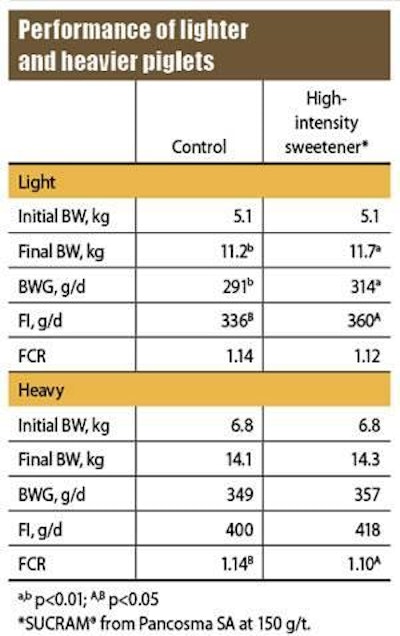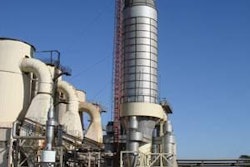
These aromas, flavours, sweeteners, or their combinations are included in feeds at dosages ranging from 100 grams to 1000 grams per metric ton depending on the product intensity. Such feed additives are designed to provoke a response from the animal's senses, to improve feed intake in situations where this is a limiting production factor.
Approximately half of the total expenditure on such palatants involves their use in diets for young pigs. The key to the healthy growth of a piglet after weaning is the development of a rapid and regular feed intake. A better pattern of feed intake at this critical stage limits the post-weaning stress syndromes that originate from the combination of being separated from the sow, transfer or transport to new housing, competition to establish a new social rankingand especially the change of diet.
Before choosing a palatant to help in this situation, however, the feed manufacturer requires information on the effectiveness of the additives available. The fund of knowledge has been increased recently by studies performed in France by the Research & Development department of the feed group Evialis.
They have investigated the potential benefits of a dietary high-intensity sweetener on the growth performance of both lightweight and heavier weaned piglets.
Light pigs more stressed
Studies were conducted in 2004 and repeated in 2005 in the same climatically controlled post-weaning nursery barn at the Evialis Research Centre. Overall, 384 Large White x Landrace piglets weaned at 21 days old were blocked by weight and sex and allocated to 48 pens. Each pen contained 8 animals.
At equal weaning age, lighter piglets are more affected by post-weaning stress than heavier piglets. They have less body reserves and are weaker. They need more time to adapt to the new conditions in post-weaning pens and to consume feed consistently. The study therefore separated the pigs into two weight groupslight and heavyin order to determine whether a dietary high-intensity sweetener would affect performance differently depending on weaning weight. Half of the pens received piglets weighing 5-6 kgconsidered as light'while the other half had heavy' pigs weighing 7-8 kg.
Treatments were defined randomly for each weight group. During the 3-week study, all the pigs were fed ad-libitum on a commercial medicated post-weaning diet (11 MJ NE, 20.8% CP) produced by Evialis at its specialised experimental feeds unit in Questembert, France (see table Performance of lighter and heavier piglets'). The sweetening palatant employed in the study was a high-intensity sweetener (SUCRAM®), provided by Pancosma, incorporated at the dosage of 150 grams per metric ton.
Regular monitoring during the study revealed that the piglets started to develop a regular pattern of daily feed intake from 1 week after weaning (see figure Feed intake evolution'). As expected, the heavier piglets consumed more feed than their lighter counterparts. Adding the high-intensity sweetener did not clearly affect their intake. On the other hand, the weaker and more highly stressed lightweight group reacted positively to the high-intensity sweetener's inclusion by increasing their feed intake as soon as a regular intake pattern appeared from Day 7 post-weaning. From then on, their intake was improved on average by 13.7%.
At the point of weaning, the 192 pigs from the lightweight group registered an average bodyweight of 5.1 kg. The other 192 pigs of the heavyweight group weighed an average of 6.8 kg. During the study period, these heavier piglets ate more, their average intake being 11.5% higher (a significant difference at p<0.05). Their bodyweight gain was greater by 16.7% (p<0.05) and their feed conversion ratio (FCR) was better by 1 point.
The inclusion of the high-intensity sweetener was beneficial for both weight categories, but especially for the lighter piglets, indicating that improved feed palatability mainly contributed to achieving better performance from pigs facing a higher stress challenge. After three weeks, those lightweight piglets receiving the high-intensity sweetener were 0.5 kg heavier than the controls. Including the high-intensity sweetener improved their feed intake by 7.1% (p<0.10) and their bodyweight gain by 7.9% (p<0.05) (see figure Relative performances').
Overall, the improvement in feed palatability from high-intensity sweetener inclusion was highly beneficial to pig performance. All performance criteria were improvedfrom feed intake and weight gain to final weight and homogeneity (see table Overall piglet performance'). At the end of the study period of 21 days, the 192 piglets fed with high-intensity sweetener were 300 grams heavier and more homogeneous, with the bodyweight standard deviation reduced by 11%.
Cost-benefit evaluation
A cost-benefit evaluation prepared on the basis of these results revealed a return-on-investment in the ratio of 1:2.8 from an additional starting cost of 1.9 per metric ton of feed for the inclusion of the high-intensity sweetener. In total, the 384 piglets earned an extra 117. The main contributor to this positive result was the 1:3.8 return-on-investment calculated for high-intensity sweetener usage in lightweight piglets.
Because feed palatability remains an important criterion in the formulation of weaner pig diets, the studies at the Evialis Research Centre illustrate a real advantage from sweetening the feed with a high-intensity sweetener. Not all piglets react equally to such an additive. The smaller and weaker onesthose for which feed intake is most limiting on growthperform relatively better than heavier and healthier ones. These findings demonstrate an approach to piglet feeding that supports the trend towards the use of hyperprolific sows. These sows farrow a larger number of piglets having lower individual bodyweights. However, using such an additive brings benefits to the whole herd, because it lifts overall performance and homogeneity while saving on costs.





.jpg?auto=format%2Ccompress&fit=crop&h=167&q=70&w=250)











